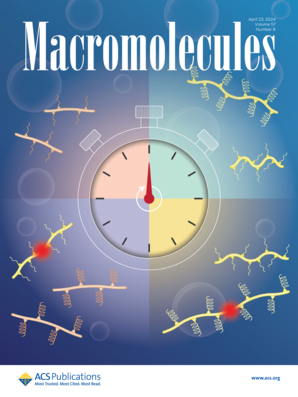聚合物熔体的集体短时动力学:两步淬火和Spinodal分解
IF 5.1
1区 化学
Q1 POLYMER SCIENCE
引用次数: 0
摘要
在聚合物熔体中,由于短时间尺度的分子内动力学,节段密度不是简单地扩散松弛。使用基于颗粒的高粗粒聚合物模型模拟,我们探索了两种不同情景下的集体短时动力学:(i)受外场两步变化影响的非相互作用聚合物链和(ii)由于吸引相互作用而引起的相分离。在两步外场的情况下,我们观察到集体密度调制的非单调弛豫行为,而对于密度调制响应于引入吸引相互作用(spinodal分解)的自发增长的情况,我们观察到在很短的时间尺度上初始的非指数增长,然后过渡到指数增长。我们证明这些效应可以被线性响应理论捕获,而动态自洽场理论(D-SCFT)总是预测段密度模式的缓慢指数弛豫。与D-SCFT的短时偏差源于两个关键特征:(i)分子构型与瞬时密度场不平衡;(ii)节段动力学表现为亚扩散行为。本文章由计算机程序翻译,如有差异,请以英文原文为准。

Collective Short-Time Dynamics in Polymer Melts: Two-Step Quenches and Spinodal Decomposition
In polymer melts, the segmental density does not simply relax diffusively due to intramolecular dynamics on short time scales. Using particle-based simulations of a highly coarse-grained polymer model, we explore the collective short-time dynamics under two distinct scenarios: (i) noninteracting polymer chains subject to a two-step change of an external field and (ii) phase separation due to attractive interactions. In the case of the two-step external field, we observe a nonmonotonic relaxation behavior of a collective density modulation, while for the case of the spontaneous growth of density modulations in response to the introduction of attractive interactions (spinodal decomposition), we observe an initial nonexponential growth on very short time scales, followed by a transition to exponential growth. We show that these effects can be captured by linear response theory, in contrast to dynamic self-consistent field theory (D-SCFT) that always predicts a slow exponential relaxation of segmental density modes. The short-time deviations from D-SCFT stem from two key characteristics: (i) the molecular configurations are not in equilibrium with the instantaneous density field, and (ii) the segmental dynamics display subdiffusive behavior.
求助全文
通过发布文献求助,成功后即可免费获取论文全文。
去求助
来源期刊

Macromolecules
工程技术-高分子科学
CiteScore
9.30
自引率
16.40%
发文量
942
审稿时长
2 months
期刊介绍:
Macromolecules publishes original, fundamental, and impactful research on all aspects of polymer science. Topics of interest include synthesis (e.g., controlled polymerizations, polymerization catalysis, post polymerization modification, new monomer structures and polymer architectures, and polymerization mechanisms/kinetics analysis); phase behavior, thermodynamics, dynamic, and ordering/disordering phenomena (e.g., self-assembly, gelation, crystallization, solution/melt/solid-state characteristics); structure and properties (e.g., mechanical and rheological properties, surface/interfacial characteristics, electronic and transport properties); new state of the art characterization (e.g., spectroscopy, scattering, microscopy, rheology), simulation (e.g., Monte Carlo, molecular dynamics, multi-scale/coarse-grained modeling), and theoretical methods. Renewable/sustainable polymers, polymer networks, responsive polymers, electro-, magneto- and opto-active macromolecules, inorganic polymers, charge-transporting polymers (ion-containing, semiconducting, and conducting), nanostructured polymers, and polymer composites are also of interest. Typical papers published in Macromolecules showcase important and innovative concepts, experimental methods/observations, and theoretical/computational approaches that demonstrate a fundamental advance in the understanding of polymers.
 求助内容:
求助内容: 应助结果提醒方式:
应助结果提醒方式:


